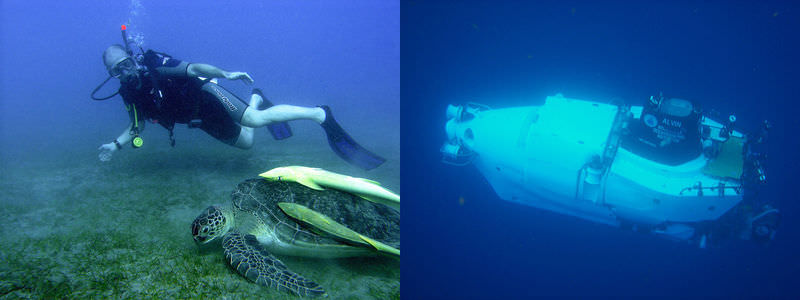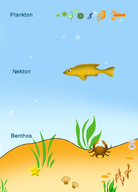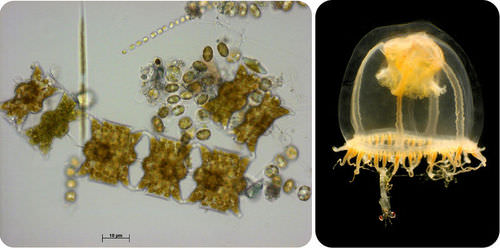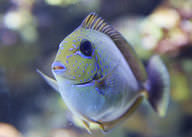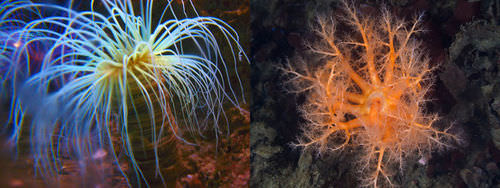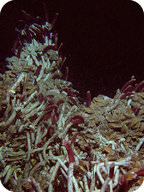18.7海洋生物的种类
章节大纲
-
How can you visit marine life?
::你怎么能访问海洋生物?It's easiest to get to the relatively shallow just offshore. Experienced divers can descend to 130 feet (43 ft), which gives them access to most marine life. Manned submersibles can descend to the bottom of the deep ocean. Where would you like to go? A coral reef or a hydrothermal vent ?
::它最容易到达相对浅浅的离岸地区。 经验丰富的潜水员可以降到130英尺( 43英尺), 这使得他们能够接触大多数海洋生物。 人造潜水器可以降落到深海底部。 您想去哪里? 珊瑚礁还是热液喷口?Living Things in the Ocean
::海洋中的活物Marine organisms range in size from tiny bacteria to the largest known animal, the blue whale. All are adapted for life in salt water . Most are adapted for extreme pressures.
::海洋生物的大小从小细菌到已知最大的动物蓝鲸不等,所有生物都适应盐水中的生活,大多数都适应极端压力。When you think of life in the ocean, do you think of fish? Actually, fish are not the most common life forms in the ocean. Plankton are the most common. Plankton make up one of three major groups of marine life. The other two groups are nekton and benthos ( Figure ).
::当你想到海洋中的生命时,你会想到鱼吗?事实上,鱼不是海洋中最常见的生命形式。普兰克顿是最常见的。普兰克顿是海洋生物的三个主要组之一。另外两个组是内克顿和底栖生物(图 ) 。Living things in the oceans are placed in these three groups.
::海洋中的生物被放在这三类生物中。Plankton
::普兰顿Plankton are living things that float in the water. Most plankton are too small to see with the unaided eye ( Figure ). Plankton are unable to move on their own. Ocean motions carry them along.
::Plankton是漂浮在水中的生物。大多数浮游生物都太小,看不到无助的眼睛(图 ) 。 Plankton无法自己移动。 海洋运动将它们随波逐流。There are two main types of plankton:
::浮游生物主要有两种类型:- Phytoplankton are “plant-like” plankton. Since they make food by photosynthesis , they live in the photic zone . Most are algae.
::植物浮游生物是“植物类”浮游生物,由于通过光合作用生产食物,它们生活在甲状腺区,大部分是藻类。
- Zooplankton are “animal-like” plankton that include tiny animals and fish larvae. They feed on phytoplankton.
::浮游动物是“类似动物的”浮游生物,包括小动物和幼虫,它们食用浮游植物。
The phytoplankton (left) and zooplankton (right) shown here have been magnified. Otherwise, they would be too small for you to see.
::这里显示的浮游植物(左)和浮游动物(右)已经放大了。 否则,它们会太小,你看不到。Nekton
::内顿Nekton are living things that swim through the water ( Figure ). They may live at any depth, in the photic or aphotic zone . Most nekton are fish, although some are mammals. Fish have fins and streamlined bodies to help them swim. Fish also have gills to take oxygen from the water.
::Nekton是游过水中的生物(图 ) 。 它们可能生活在任何深处, 无论是在火山还是光伏区。 大部分的Nekton是鱼类, 尽管有些是哺乳动物。 鱼有鳍和精细的体格来帮助他们游泳。 鱼也有刺来从水中取氧。Nekton swim through ocean water.
::Nekton在海水中游泳Benthos
::底栖Benthos are living organisms on the ocean floor. Many benthic organisms attach themselves to and stay in one place. This protects them from crashing waves and other water movements. Some benthic organisms burrow into sediments for food or protection. Benthic animals may crawl over the ocean floor. Examples of benthos include clams and worms. Pictured below are two other examples ( Figure ).
::底栖生物是洋底的生物体,许多底栖生物附着在一个地方,并停留在一个地方,这样可以保护它们免受波浪和其他水流的冲击。一些底栖生物钻入沉积物,以获取食物或保护。底栖动物可能爬过洋底。底栖生物的例子包括蛤和蠕虫。下面有另外两个例子(图 ) 。These animals live on the ocean floor.
::这些动物生活在洋底上Some benthos live near vents on the deep ocean floor. Tubeworms are an example ( Figure ). Scalding hot water pours out of the vents. The hot water contains chemicals that some specialized bacteria can use to make food. Tubeworms have the bacteria living inside them. The bacteria get protection and the tubeworms get some of the food.
::一些底栖动物生活在深海海底的通风口附近。管虫就是一个例子(图 )。热水从喷口中涌出。热水含有某些专门细菌可以用来生产食物的化学物质。管虫体内有细菌。细菌得到保护,管虫得到一些食物。Tubeworms live near hot water vents on the deep ocean floor.
::管虫生活在深海海底热水喷口附近。Summary
::摘要- Plankton are tiny organisms that are swept along on currents. Phytoplankton are tiny plant-like organisms. Zooplankton are tiny animals.
::Plankton是小生物,在洋流上横扫而过。Phyto浮游生物是植物类的微小生物。动物浮游生物是小动物。
- Nekton are organisms that go through the water under their own power. Fish and marine mammals are nekton.
::Nekton是自力穿过水的有机体,鱼类和海洋哺乳动物是Nekton。
- Benthos bury in the sediment, attach to rocks, or crawl over the seafloor.
::底栖生物埋在沉积物中,附在岩石上,或爬过海底。
Review
::回顾- Compare and contrast phytoplankton and zooplankton.
::对比和对比浮游植物和浮游动物
- How are nekton adapted to life in the sea?
::Nekton如何适应海洋中的生活?
- How are benthos adapted to life in the sea?
::海底人如何适应海洋中的生活?
- Phytoplankton are “plant-like” plankton. Since they make food by photosynthesis , they live in the photic zone . Most are algae.
